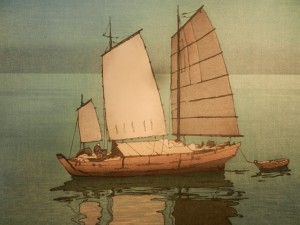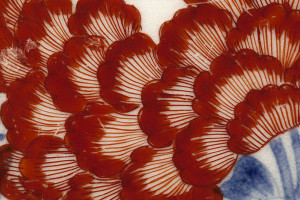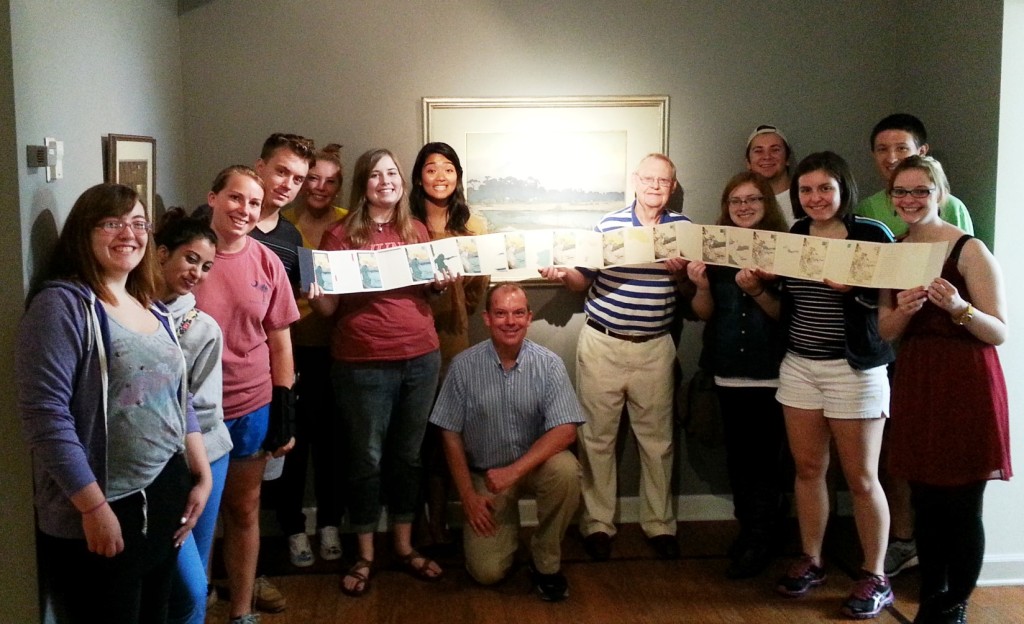I have always loved Japanese art. So, when I learned that my Asian Politics class was attending the OU Museum of Art’s Japanese art exhibition as part of learning about Japanese history and culture—I freaked. Two things I love had come together: learning and art.

Yoshida’s woodcut “Sending Boats” series especially stood out to Jacob Tadych ’14 in Dr. Steen’s Japanese Literature class.
Both my class, taught by Dr. Stephen Herschler, and Dr. Robert Steen’s Japanese Literature class took full advantage of having the exhibition right here on our campus at the beginning of this semester. Jiki to Hanga: Japanese Porcelain and Prints helped our classes see art as a reflection of a culture and current events, and to explore how art is a means through which cultures can exchange ideas with one another.
“Learning is more effective when it is attached to the real world and becomes not just theoretical but experiential as well,” said Dr. Herschler. “It was an incredible opportunity…(and) a truly fabulous way for the Asian Politics class to start the semester, using art to learn about not just different cultures but also philosophy, international commerce, and politics as reflected in the techniques, materials, and aesthetics of specific artistic works.”

Porcelain Detail: Artist unknown. Arita, Japan, late 17th century. Collection of Oglethorpe University. Gift of Carrie Lee Jacobs Henderson.
Some of the porcelain pieces on view, for example, showed how Western culture influenced Eastern culture. Traditional Japanese art forms are stoic and minimalist, but that contrasted with the vibrant pieces created by the Japanese for Westerners to display in their Victorian era households.
The displayed works by master printmaker Hiroshi Yoshida gave students a snapshot of Japanese culture in transition from a feudalistic society to the current industrial power. His use of traditional Japanese woodcuts and the European oil and watercolor painting techniques shows the balancing act that resulted from the mash of cultural ideals following WWII. Yoshida’s works are traditional in their minimalism, but also very impactful in that the cultural transition is gently introduced to the viewer. Most prints in the exhibit showed very traditional scenes, like Mount Fuji and shrines or fishermen on sailboats throughout the day, while others showed the shops at night seeming to suggest the beginning of using electric lights by the intensity of the shadows and the use of Western techniques.
Dr. Steen’s class was studying post WWII Japanese literature, coinciding with the time period of the Yoshida prints. His class used the exhibit as context for discussing the cultural transitions in Japan at that time and the effects on the country’s literature. “Art tells stories and I have my students write about those stories,” said Dr. Steen, who uses the themes of memory, cultural identity and travel to relate the texts back to differences in perspective. “There are many ways to make connections to the ideas that we talk about in class, even if they aren’t directly related.”
Elizabeth Peterson, the director of the OU Museum of Art, is thrilled that the classes were able to use the exhibit to compliment their classroom curriculum. “This is precisely why universities have museums—as more than a lovely place to visit—it’s an academic treasure trove for students.”

Dr. Herschler’s Asian Politics Class with Dr. Terry Taylor.
